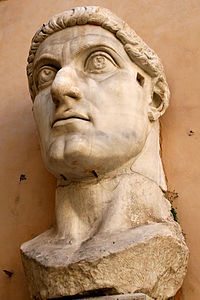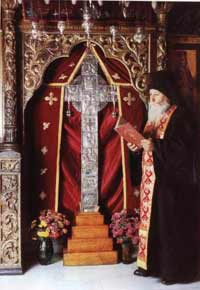
Another very important Feast Day that is celebrated in Greece is that of the Feast of the Holy Cross on September 14. It commemorates the cross used in the crucifixion of Jesus Christ.
Saint Helen, and through her, her son, Saint Constantine, are directly connected with the finding of the True Cross and therefore the celebrating of this event.
Saint Helen (Greek: Αγία Ελένη – c250 – 330 AD), was born in Bithynia in Asia Minor, in today’s Turkey. The capital of Bithynia was Nicomedia (Greek: Νικομήδεια), the capital of the East Roman Empire during the rule of Emperor Diocletian. She was of Greek origin and of common birth. She was the wife of Constantius, who had the title of Ceasar and ruled the area of Gaul and Brittania. Her son Constantine would become the sole Emperor of the Roman Empire after the death of Emperor Diocletian and the defeat of Licinius, one of the Caesars, at the Battle of Chrysopolis on 18 September 324.
 Constantine served in the army of Emperor Diocletian in the eastern part of the Roman Empire, whose capital city was Nicomedia. However, he did not agree with the persecution of the Christians that took place between 303-311. It was the largest and bloodiest persecution that had ever taken place during this period of internal strife as well as external threats to the Empire. Even before Constantine became Emperor of the Roman Empire, he had adopted the sign of chi and ro (the first letters of Christ in Greek – Χριστός) on his military banner (Greek: λάβαρον / English -labarum) during his battles.
Constantine served in the army of Emperor Diocletian in the eastern part of the Roman Empire, whose capital city was Nicomedia. However, he did not agree with the persecution of the Christians that took place between 303-311. It was the largest and bloodiest persecution that had ever taken place during this period of internal strife as well as external threats to the Empire. Even before Constantine became Emperor of the Roman Empire, he had adopted the sign of chi and ro (the first letters of Christ in Greek – Χριστός) on his military banner (Greek: λάβαρον / English -labarum) during his battles.

When Constantine became Emperor in 306, he created the city of Constantinople (Greek: Κωνσταντινούπολη – πόλη means city) on the former site of the ancient Greek city of Byzantium (Greek: Βυζάντιον) on the Bosporus. Byzantium was colonized by the Greeks from the city of Megara in 657 BC. Today, it is called Istanbul and is Turkey’s economic, cultural and historic centre. However, the aftermath of the Byzantine Empire, which covered a thousand years of rule and which spread the Christian religion to all of Asia Minor, can still be seen in the monuments and in many of the churches that are standing and still in use today. However, Agia Sophia, the symbol of Christianity has been turned into a museum by the Turkish government.
Constantine put a stop to the persecution of Christians and legalised the Christian religion along with all other religions and cults of the Roman Empire. The Edict of Milan that was signed in February 313 was a turning point in the practicing of the Christian religion as it allowed Christians to follow their faith without persecution. He helped the Church financially, built Churches and gave privileges to the clergy. He also returned confiscated property to the Church.
 His most famous building projects were the Church of the Holy Sepulchre in the Old City of Jerusalem and the Old St. Peter’s Basilica in the position of today’s St. Peter’s Basilica in Vatican City. In 321, he decreed that Sunday should be a day of rest for
His most famous building projects were the Church of the Holy Sepulchre in the Old City of Jerusalem and the Old St. Peter’s Basilica in the position of today’s St. Peter’s Basilica in Vatican City. In 321, he decreed that Sunday should be a day of rest for  all citizens. He also issued new coins with the symbols of chi ro (Greek: Χ – Ρ) to celebrate the new beginning where the figures of the old gods were replaced or assimilated into the framework of Christian symbolism.
all citizens. He also issued new coins with the symbols of chi ro (Greek: Χ – Ρ) to celebrate the new beginning where the figures of the old gods were replaced or assimilated into the framework of Christian symbolism.
Another important turning point was the summoning of the First Council of Nicaea in 325, the first ecumenical council of the Christian church, which settled Christian doctrine for ages.
Emperor Constantine was over forty when he embraced Christianity, but he was not baptised until just before his death in 337 AD. He fell ill soon after the Feast of Easter in 337 near the city of Helenopolis (Greek: Ελενόπολις), formerly called Drepana (Greek: Δρέπανα). Emperor Constantine renamed the city to honour his mother, Helena. He tried to return to Constantinople, but made it as far as Nicomedia. There he requested that he be baptised. He died on 22 May 337. His body was transferred to Constantinople and buried in the Greek Orthodox Church of the Holy Apostles.
Constantine was honoured with the title of ‘The Great’ (Greek: Μέγας) after he died, not only for his role in establishing Christianity, but also for his military career. He united the Roman Empire under one ruler and was the longest-serving emperor after Emperor Augustus. When the Roman Empire was divided into West and East, the Byzantine Empire in the east considered Constantine its founder.
His mother, Helena (Greek: Ελένη), is an important figure in the consolidation of Christianity due to the influence she had over her son and for her support of the new religion. She went to Jerusalem on a pilgrimage in search of the True Cross. It was found on Golgotha, under a temple dedicated to the goddess Aphrodite. As there were three crosses, the Bishop of Jerusalem, Macarius, determined which was the True Cross. It is also said that Helena had a local woman, who was near death, touch the crosses. When she touched one of the crosses, she recovered. It was declared as being the True Cross. The other two belonged to the thieves that had been crucified along with Jesus Christ. Furthermore, tradition has it that basil was growing on the spot where the True Cross was found. That is why basil is used to decorate the icon of the Holy Cross and used generally in all church procedures.

Pieces of the Holy Cross and other relics were taken to Constantinople and Rome as well as being placed in the Church of the Holy Sepulchre in Jerusalem. There are also pieces of the Holy Cross, a nail and the rope with which Jesus was tied on the cross in Cyprus at the Stavrovouni Monastery on the hill called Stavrovouni outside the city of Larnaca. The hill is dedicated to the Holy Cross as indicated by the name: Stavro means Cross and vouno means mountain. It basically means the mountain of the Cross.
Helena returned to Rome with pieces of the Holy Cross and other relics. They were stored in her palace, a part of which was later converted into the Basilica of the Holy Cross in Jerusalem. At that time, the floor of the church was covered with soil from Jerusalem, hence its name. It is one of the Seven Pilgrim Churches of Rome.
Saint Helena died around 330 AD with her son at her side. She was buried in the Mausoleum of Helena outside Rome. It had originally bee n built for Emperor Constantine. Her sarcophagus is on display at the Vatican Museum.
n built for Emperor Constantine. Her sarcophagus is on display at the Vatican Museum.

Both Saint Constantine and Saint Helen celebrate their Feast Day on the same day, which is 21 May. Many churches throughout Greece are dedicated to these two saints, making them the patron saints of the suburb or village in which they are located.